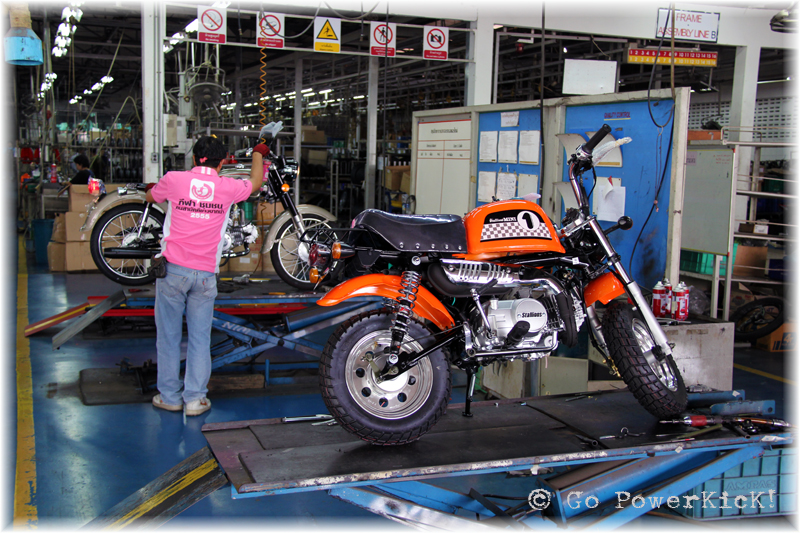Riding around Bangkok, and taking trips to neighboring provinces, I haven’t noticed too many 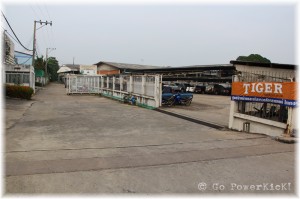 other Tiger Motorcycles on the road (except for the Police). Whether at a stop light, or stuck in thick Bangkok traffic, my bike and I are usually greeted with a Thai smile or a thumbs up from other riders and motorbike taxi’s. One recent acknowledgement came in a ‘let’s race’ look from a motorbike rider while at a red light, and I couldn’t help but agree. As soon as the light turned green we were drag racing stoplight to stoplight. Experiences like these have built a curiosity in me to learn more about the company that makes the motorcycle I ride. During a recent break in my schedule I decided to contact the factory and inquire about a tour to see where Tiger Motorcycles come to life.
other Tiger Motorcycles on the road (except for the Police). Whether at a stop light, or stuck in thick Bangkok traffic, my bike and I are usually greeted with a Thai smile or a thumbs up from other riders and motorbike taxi’s. One recent acknowledgement came in a ‘let’s race’ look from a motorbike rider while at a red light, and I couldn’t help but agree. As soon as the light turned green we were drag racing stoplight to stoplight. Experiences like these have built a curiosity in me to learn more about the company that makes the motorcycle I ride. During a recent break in my schedule I decided to contact the factory and inquire about a tour to see where Tiger Motorcycles come to life.
Tiger traces its roots back to a partnership with Thai Kawasaki. The factory, 25 km south of 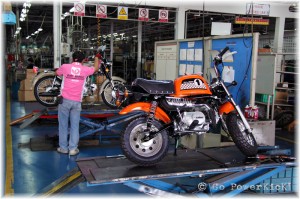 Bangkok in Samut Prakan, was the initial location where design and assembly of Kawasaki’s took place in Thailand. As the Asian financial crisis ripped through the region in the late 90’s, Thai Kawasaki was doing what it could to stay alive. The ultimate result of the crisis was a parting of ways between Kawasaki and the Thai partners, however; the Thai partners held onto the factory as they saw an opportunity to begin a new chapter of motorcycles built in Thailand.
Bangkok in Samut Prakan, was the initial location where design and assembly of Kawasaki’s took place in Thailand. As the Asian financial crisis ripped through the region in the late 90’s, Thai Kawasaki was doing what it could to stay alive. The ultimate result of the crisis was a parting of ways between Kawasaki and the Thai partners, however; the Thai partners held onto the factory as they saw an opportunity to begin a new chapter of motorcycles built in Thailand.
While strolling the factory floor with my guide, Khun Pariya, he shared the history after the split with Kawasaki. Teaming up with the Italian company Cagiva, they began to design a new 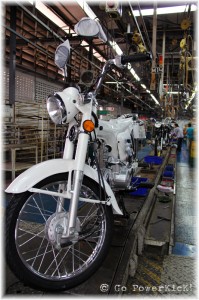 cutting edge style of bikes. The direct results of their craftsmanship were the Stella, a two stoke 125cc step-through/sport model, and the F4, a 4stroke 150cc naked sport bike. These innovative new designs gained popularity, and 2002 saw the emergence of the ‘Tiger’ brand.
cutting edge style of bikes. The direct results of their craftsmanship were the Stella, a two stoke 125cc step-through/sport model, and the F4, a 4stroke 150cc naked sport bike. These innovative new designs gained popularity, and 2002 saw the emergence of the ‘Tiger’ brand.
Their 114,000 sq meter factory is something Henry Ford and Steve Jobs would both be quite proud of. A cross between hand-crafted assembly line techniques and 21st century technology; the factory handles everything from R&D, testing, manufacturing and logistics on-site.
The popularity of Tiger motorcycles spans the country; although Northern and Southern Thailand seem to have the largest appetites as Bangkok remains mostly a superbike hub. Tiger bikes have also gained international appeal and are popular in both the Philippines and Malaysia.
When the factory was firing on all cylinders Tiger was producing around 6,000 bikes per 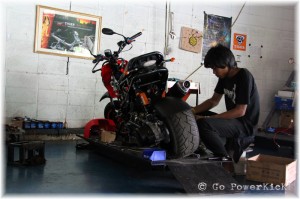 month. Today they have strategically slowed their pace and produce around 1,200 bikes per month; ranging from popular Retro models, to the F4 (which has come back to replace the Boxer) and the newly designed wicked looking Street Bomber.
month. Today they have strategically slowed their pace and produce around 1,200 bikes per month; ranging from popular Retro models, to the F4 (which has come back to replace the Boxer) and the newly designed wicked looking Street Bomber.
The factory also does contract assembly for the Chinese brand Stallion as well as joint design and production for BigBull, creators of the King Kong. Tuskigi Racing developed a 2-decade long partnership with Tiger after initially sharing endurance racing pits in Japan back in the 80’s. Today that partnership sees shared R&D facilities, as well as product collaboration with Tuskigi exhaust kits placed on the Boxer and other models.
As the competitive nature of the industry develops, Tiger is looking to capitalize on the  attractiveness of their Retro model. Currently in design phases is a new, suped-up, engine which looks to position the bike competitively against the Honda Wave’s, Yamaha Fino’s and Suzuki Shogun’s of the 125cc motorbike taxi world.
attractiveness of their Retro model. Currently in design phases is a new, suped-up, engine which looks to position the bike competitively against the Honda Wave’s, Yamaha Fino’s and Suzuki Shogun’s of the 125cc motorbike taxi world.
After visiting the factory I definitely feel the history and personalized touch behind Tiger bikes, and their slogan “It’s our passion and your ride” has taken on an entirely new meaning. Who knows what the future has in store but perhaps, similar to their supplying of bikes to the Thai Police department, Tiger will be one day be outfitting fleets of motorbike taxi’s in Bangkok and outer provinces.
Comments
More Good Reads!

Helicopter Over Oahu
May 10, 2014
May 2014 PowerKicK Of The Month
May 01, 2014
Bike The Golden Gate Bridge
April 29, 2014
Hua Hin Hills Vineyard
April 19, 2014
Songkran in Nan
April 10, 2014
April 2014 PowerKicK Of The Month
April 01, 2014
Mae Hong Son Motorcycle Loop: Mae Sot to Mae Hong Son
March 28, 2014
Becoming A Buddhist Monk In Thailand
March 20, 2014






